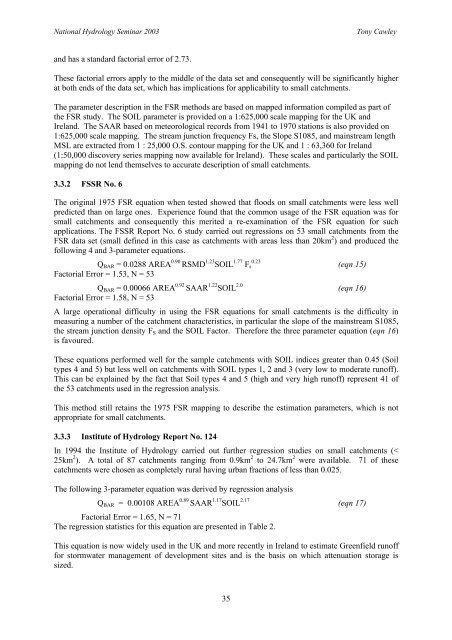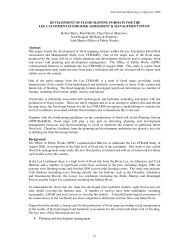COMMENT ON ESTIMATION OF GREENFIELD RUNOFF RATES ...
COMMENT ON ESTIMATION OF GREENFIELD RUNOFF RATES ...
COMMENT ON ESTIMATION OF GREENFIELD RUNOFF RATES ...
Create successful ePaper yourself
Turn your PDF publications into a flip-book with our unique Google optimized e-Paper software.
National Hydrology Seminar 2003<br />
Tony Cawley<br />
and has a standard factorial error of 2.73.<br />
These factorial errors apply to the middle of the data set and consequently will be significantly higher<br />
at both ends of the data set, which has implications for applicability to small catchments.<br />
The parameter description in the FSR methods are based on mapped information compiled as part of<br />
the FSR study. The SOIL parameter is provided on a 1:625,000 scale mapping for the UK and<br />
Ireland. The SAAR based on meteorological records from 1941 to 1970 stations is also provided on<br />
1:625,000 scale mapping. The stream junction frequency Fs, the Slope S1085, and mainstream length<br />
MSL are extracted from 1 : 25,000 O.S. contour mapping for the UK and 1 : 63,360 for Ireland<br />
(1:50,000 discovery series mapping now available for Ireland). These scales and particularly the SOIL<br />
mapping do not lend themselves to accurate description of small catchments.<br />
3.3.2 FSSR No. 6<br />
The original 1975 FSR equation when tested showed that floods on small catchments were less well<br />
predicted than on large ones. Experience found that the common usage of the FSR equation was for<br />
small catchments and consequently this merited a re-examination of the FSR equation for such<br />
applications. The FSSR Report No. 6 study carried out regressions on 53 small catchments from the<br />
FSR data set (small defined in this case as catchments with areas less than 20km 2 ) and produced the<br />
following 4 and 3-parameter equations.<br />
Q BAR = 0.0288 AREA 0.90 RSMD 1.23 SOIL 1.77 0.23<br />
F s (eqn 15)<br />
Factorial Error = 1.53, N = 53<br />
Q BAR = 0.00066 AREA 0.92 SAAR 1.22 SOIL 2.0 (eqn 16)<br />
Factorial Error = 1.58, N = 53<br />
A large operational difficulty in using the FSR equations for small catchments is the difficulty in<br />
measuring a number of the catchment characteristics, in particular the slope of the mainstream S1085,<br />
the stream junction density F S and the SOIL Factor. Therefore the three parameter equation (eqn 16)<br />
is favoured.<br />
These equations performed well for the sample catchments with SOIL indices greater than 0.45 (Soil<br />
types 4 and 5) but less well on catchments with SOIL types 1, 2 and 3 (very low to moderate runoff).<br />
This can be explained by the fact that Soil types 4 and 5 (high and very high runoff) represent 41 of<br />
the 53 catchments used in the regression analysis.<br />
This method still retains the 1975 FSR mapping to describe the estimation parameters, which is not<br />
appropriate for small catchments.<br />
3.3.3 Institute of Hydrology Report No. 124<br />
In 1994 the Institute of Hydrology carried out further regression studies on small catchments (<<br />
25km 2 ). A total of 87 catchments ranging from 0.9km 2 to 24.7km 2 were available. 71 of these<br />
catchments were chosen as completely rural having urban fractions of less than 0.025.<br />
The following 3-parameter equation was derived by regression analysis<br />
Q BAR = 0.00108 AREA 0.89 SAAR 1.17 SOIL 2.17 (eqn 17)<br />
Factorial Error = 1.65, N = 71<br />
The regression statistics for this equation are presented in Table 2.<br />
This equation is now widely used in the UK and more recently in Ireland to estimate Greenfield runoff<br />
for stormwater management of development sites and is the basis on which attenuation storage is<br />
sized.<br />
35

















